Transform your snack game and elevate your meals with the most flavorful spiced pumpkin seeds you’ve ever tasted! This guide invites you on a culinary journey, showcasing three incredible store-bought global spice blends from Ethiopia, Japan, and the Middle East. These “flavor blast” seasonings are guaranteed to turn simple pumpkin seeds into a crunchy, aromatic topping that will become your new obsession, perfect for everything from vibrant Buddha Bowls to elegant charcuterie boards.
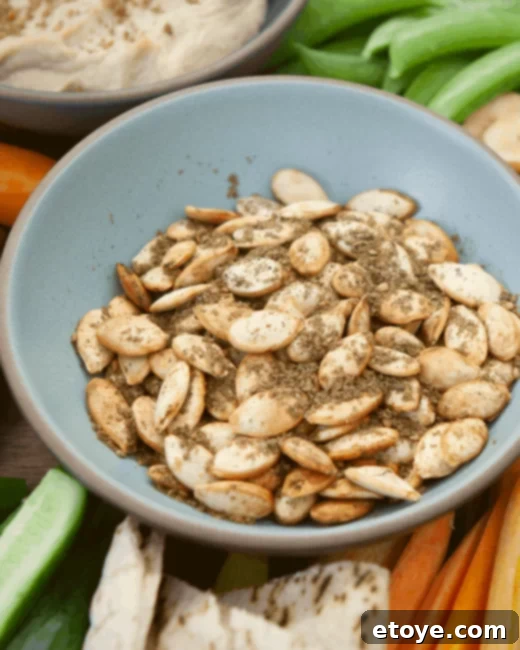
Are you ready to discover three fresh, exciting, and incredibly easy ways to make roasted pumpkin seeds more enticing than ever before? Forget plain salt; it’s time to unlock a world of complex flavors and textures that will utterly delight your palate.

I’m thrilled to introduce you to a trio of tantalizing spice blends from across the globe. Each one offers a unique and unforgettable profile, and I’ll show you how to harness their power to create flavor-packed roasted pumpkin seeds – a simple snack that can effortlessly enhance a myriad of other dishes. Let’s face it: while classic sea salt is comforting, culinary exploration is where true joy lies. These blends deliver what I affectionately call “massive flavor blasts“—complex, layered tastes that elevate the humble pumpkin seed to gourmet status.
Starting with pumpkin seeds is an ideal entry point into using these extraordinary spice blends. They’re quick to prepare, incredibly versatile, and allow the distinct character of each spice to truly shine. Before you know it, these international seasonings will become indispensable staples in your weekly cooking routine.
Za’atar: The Aromatic Essence of the Middle East
Our first stop on this spice adventure takes us to the vibrant kitchens of the Middle East with Za’atar (pronounced zuh-TAR). More than just a seasoning, Za’atar is a cultural cornerstone, often referring to a wild thyme plant itself, but primarily known as a beloved spice blend. This exquisite mix typically features dried oregano, thyme, sumac, and toasted sesame seeds. The result is a simultaneously woodsy, floral, tangy, and nutty flavor experience that is both ancient and utterly contemporary.

Za’atar’s versatility knows no bounds. Sprinkle it generously onto creamy hummus, roasted vegetables, or even avocado toast for an instant flavor upgrade. One of my favorite ways to enjoy it is by toasting flatbread or pita bread brushed with olive oil and a lavish coating of za’atar until crisp and fragrant. And, of course, it’s absolutely phenomenal for roasting pumpkin seeds, infusing them with its distinct Middle Eastern charm. The slightly sour tang of sumac paired with the earthy herbs and nutty sesame creates an addictive crunch that’s hard to resist.
The Za’atar-spiced roasted pumpkin seeds are a perfect addition to a gorgeous hummus board, transforming it into a stunning and flavorful appetizer or grazing platter ideal for Fall and Winter gatherings. Their unique texture and robust flavor provide a wonderful contrast to the smooth hummus and fresh vegetables.
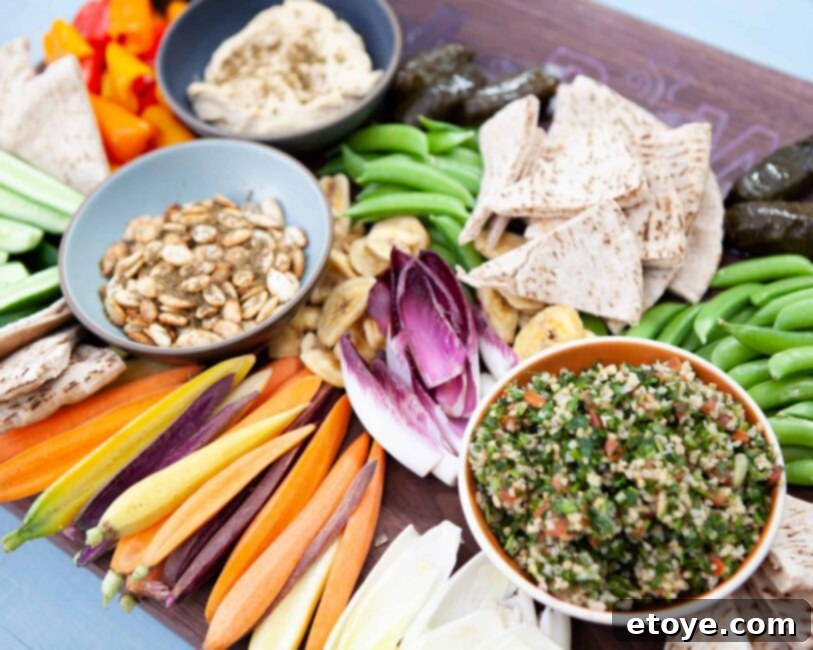
When selecting your Za’atar, you’ll find various blends available, each with subtle differences in herb ratios and additional ingredients. Here are a few examples to guide your choice:
- A classic blend featuring Marjoram, Oregano, Thyme, and Sesame.
- A robust option with Thyme, sesame seeds, and sumac.
- A more complex profile including Sumac, sesame, ground cumin, thyme, oregano, and salt.
Each blend offers a slightly different nuance, allowing you to find the perfect Za’atar to match your budget and flavor preferences for your roasted pumpkin seeds and beyond.
Berbere: Your Go-To Warming Spice for Colder Months
Next, we journey to the heart of East Africa to discover Berbere (pronounced BEAR-bur-ay), the soulful and aromatic spice blend central to Ethiopian cuisine. This captivating blend is a symphony of warming spices, including an array of chilis, cardamom, cloves, garlic, ginger, and sometimes fenugreek or allspice. Despite its bold red color, which might suggest intense heat, Berbere offers a nuanced flavor profile that is more warm and smoky than overtly spicy. It provides a deep, complex warmth that slowly blooms on the palate, making it a truly comforting seasoning.
If you’ve never had the pleasure of tasting Berbere, I implore you to seek it out. It’s more than just a spice; it’s an experience. Its unique character will quickly elevate it to one of your most cherished go-to seasonings. Honestly, this is the spice I find myself dreaming about, eager to incorporate into my next meal.
Beyond pumpkin seeds, Berbere shines brilliantly on grilled meats. My personal favorite way to use this spice is on chicken or pork, where its robust flavors perfectly complement the char and succulence of the grill. When roasted in the oven, as with our pumpkin seeds, Berbere’s warming notes intensify beautifully, filling your kitchen with an intoxicating aroma. These Berbere-spiced pumpkin seeds are an exquisite addition to any charcuterie and cheese board, offering an unexpected burst of global flavor that pairs wonderfully with a variety of cheeses, cured meats, and fruits.
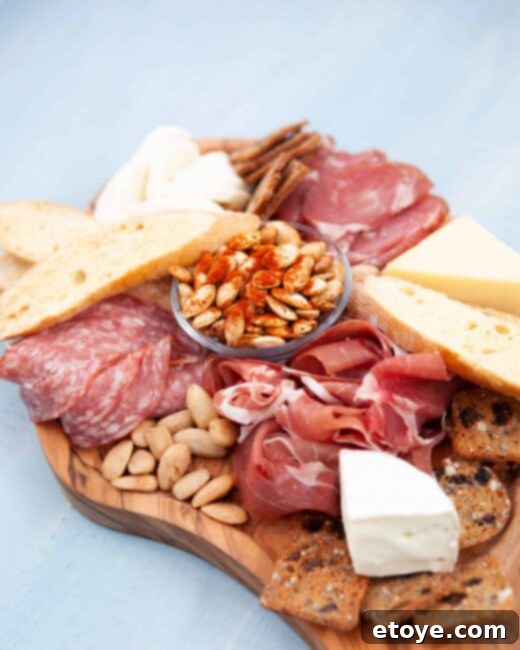
Imagine setting the scene: a beautifully arranged board featuring these warm, smoky pumpkin seeds, a couple of glasses of your favorite wine, and the smooth sounds of Barry White playing in the background. You’ve just created an entire, effortlessly sophisticated meal right there. You can find quality Berbere blends like this one: Zamouri Spices Berbere Blend.
Shichimi Togarashi: The Seven-Flavor Chili of Japan
Our final destination brings us to Japan for the vibrant and dynamic Shichimi Togarashi (pronounced she-CHEE-mee toe-ga-RAH-she). Translated as “seven-flavor chili pepper,” this iconic Japanese spice blend is a masterclass in balance and complexity. It’s crucial not to confuse it with ichimi togarashi, which, despite a similar bottle, contains only one chili pepper ingredient. In Japanese, “shichi” means seven, and “ichi” means one—a simple distinction for a world of flavor difference.
shichi = seven in Japanese
ichi = one in Japanese
Your lucky seven Shichimi Togarashi blend is a delightful medley of ingredients, carefully chosen for their individual contributions to the overall flavor profile. It typically includes red chili peppers for heat, orange peel for a bright, citrusy note, ginger for warmth and pungency, black and white sesame seeds for nuttiness, poppy seeds for a subtle crunch, and sometimes nori (seaweed) for a whisper of umami. This unique combination creates a truly one-of-a-kind seasoning that awakens the senses.
Among our three global spice blends, Shichimi Togarashi is undoubtedly the spiciest, but it delivers a pleasant, manageable kick right at the tip of your tongue rather than an overwhelming burn. You’ll often find this pepper, along with ichimi togarashi, as a ubiquitous finishing spice on tables at ramen and udon shops across Japan, encouraging diners to customize their noodle bowls to their preferred level of zest.
Beyond its traditional uses, Shichimi Togarashi excels in unexpected applications. My favorite non-traditional uses? A generous sprinkle on French fries or popcorn transforms them into incredibly addictive, slightly spicy, and deeply flavorful snacks! For our roasted pumpkin seeds, Shichimi Togarashi adds a fantastic crunchy, spicy, and umami-rich topping to a Japanese Poke Buddha Bowl. I often use store-bought poke for a quick and simple lunch, and these pumpkin seeds provide a truly fun, flavorful, and textural contrast.

When preparing your poke bowl pepitas, you’ll notice they typically lack their shells. While keeping the shells on is perfectly fine for finger foods like charcuterie boards, it’s generally best to use shelled pumpkin seeds (pepitas) when adding them to Buddha bowls, salads, and other dishes eaten with a fork or spoon for a smoother eating experience. A great Shichimi Togarashi to try is: McCormick Gourmet Japanese 7 Spice Seasoning.
Regardless of which incredible spice blend you choose, the method for roasting pumpkin seeds remains wonderfully simple and consistent.
How to Roast Pumpkin Seeds – Step by Step to Perfection
Achieving perfectly crispy, flavorful roasted pumpkin seeds is an incredibly straightforward process. You’ll want to start with dry, untoasted pumpkin seeds, which can be either shelled or unshelled. Often, you’ll find shelled pumpkin seeds packaged as “pepitas” – it’s simply a fun, Mexican-Spanish name for the same delicious seed.

If you’re starting with raw seeds directly from a fresh pumpkin, a little prep work is needed to get them ready for roasting. Here’s how to prepare them:
- **Rinse Thoroughly:** Gently rinse the pumpkin seeds under cold water to remove any clinging pumpkin pulp or fibrous strands. Ensure they are as clean as possible.
- **Dry Completely:** Spread the rinsed pumpkin seeds on a baking sheet and heat them in a warm oven (around 200 degrees F or 95 degrees C) until they are completely dry to the touch and easy to crack open. Alternatively, you can air dry them in the sun or use a dehydrator for several hours until all moisture is gone. This step is crucial for achieving maximum crispness.
- **Shell if Desired:** If you prefer shelled pumpkin seeds (pepitas) for dishes like Buddha bowls or salads, carefully crack and peel the dried seeds. This step is optional if you plan to eat them with the shell on, which is perfectly fine for a crunchy snack!
Once your pumpkin seeds are dry and prepped, the roasting process is incredibly simple. Just toss the dry (not yet toasted) pumpkin seeds directly on a baking sheet. Drizzle them with a bit of olive oil to ensure an even coating, then generously sprinkle with your chosen spice blend—Za’atar, Berbere, or Shichimi Togarashi. Don’t be shy with the seasoning; the flavors will mellow slightly in the heat of the oven.
Spread the coated seeds in a single layer on the baking sheet. Bake them in a preheated oven until they are beautifully golden, fragrant, and develop a satisfying crunch with a nice snap. The spices will form a lovely, aromatic coating on each seed, making them irresistible.
Yes, it’s that easy! You mix and bake them all on the same pan, minimizing cleanup and maximizing deliciousness.
Expert Tips for Perfect Roasted Pumpkin Seeds
- **Watch Closely to Prevent Burning:** Pumpkin seeds can go from perfectly toasted to burnt in a flash. Keep a close eye on them during the final minutes of roasting. Once they are golden brown and smell fragrant, immediately remove them from the hot baking sheet to a cool surface (like a clean plate or another pan) to stop the cooking process and prevent them from scorching.
- **Be Generous with Seasonings:** Don’t hesitate to use a liberal hand when sprinkling on your spice blends. The intense heat of the oven tends to mellow out the potency of spices, so a generous initial coating will ensure the final product is bursting with flavor. You can always add a little extra pinch of salt or seasoning right after roasting, if desired, for an extra flavor boost.
- **Shell On or Off? Match to Your Serving Style:** For a rustic, finger-food snack perfect for grazing boards or enjoying straight from the bowl, roasting pumpkin seeds with their shells on adds extra crunch and fiber. If you’re incorporating them into salads, Buddha bowls, soups, or any dish eaten with a utensil, shelled pepitas offer a smoother, less intrusive texture.
- **Enjoy the Whole Seed!** Many people wonder if they should shell roasted pumpkin seeds. The answer is entirely up to personal preference! I personally eat roasted pumpkin seeds, shell and all. The shell, once roasted, becomes delightfully thin and crispy, adding an extra layer of texture and fiber. There’s no need to bother with shelling them unless you prefer the specific mouthfeel of shelled pepitas for certain dishes.
These expertly roasted and spiced pumpkin seeds are not just a snack; they are a versatile ingredient that can elevate many dishes.
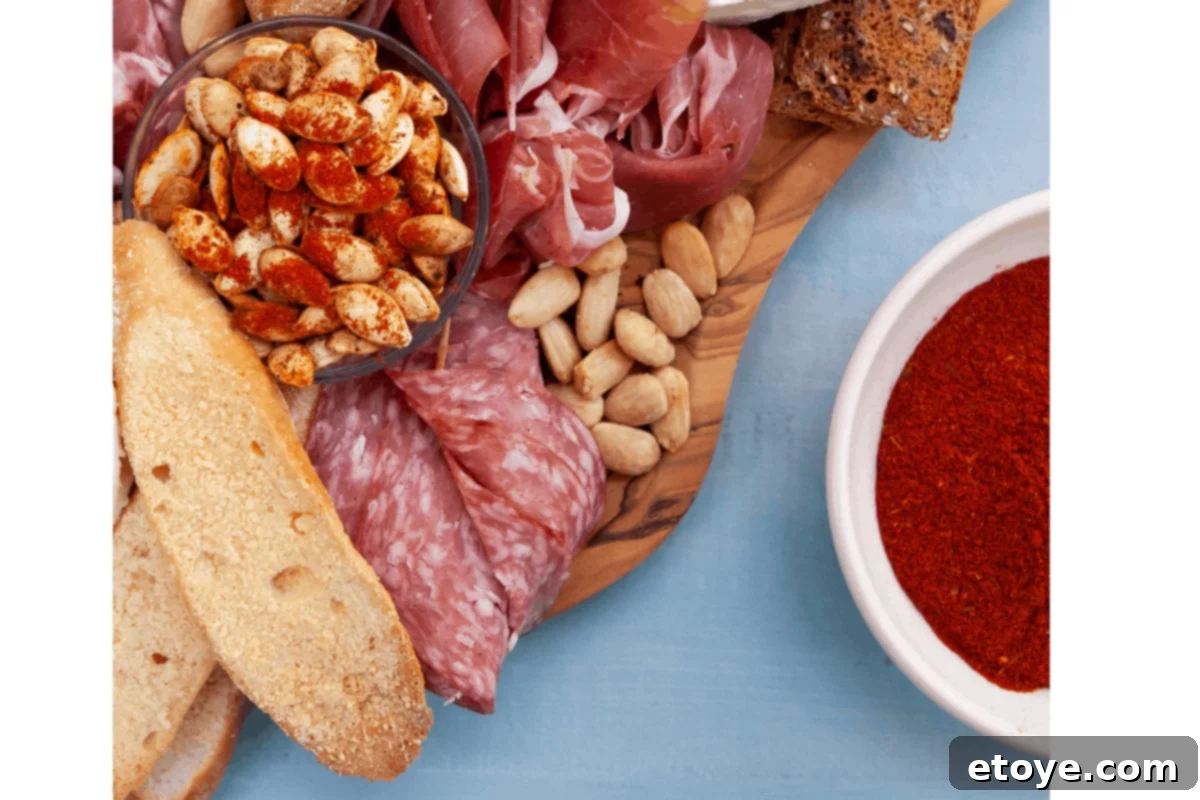
Beyond Pumpkin Seeds: Expanding Your Culinary Horizon with Global Spices
These three global spice blends are incredibly versatile and can transform a multitude of dishes beyond just pumpkin seeds. Don’t let their use stop here!
Unlocking the Power of Za’atar
Za’atar is a kitchen superhero. Its herbaceous, tangy profile makes it fantastic for savory applications.
- **Marinades and Rubs:** Use it as a dry rub for chicken, lamb, or fish before grilling or roasting.
- **Vegetable Roasts:** Elevate simple roasted cauliflower, carrots, or bell peppers with a generous sprinkle.
- **Bread and Dips:** Mix with olive oil for a delightful dipping sauce for crusty bread, or spread on flatbread before baking for an authentic treat. Check out this Homemade Za’atar recipe if you’re feeling adventurous, and try it on roasted potatoes!
- **Eggs:** A pinch of Za’atar over scrambled eggs or a fried egg adds a surprising depth of flavor.
Embracing the Warmth of Berbere
Berbere, with its comforting warmth and smoky undertones, is perfect for heartier dishes, especially during colder months.
- **Stews and Lentils:** It’s the essential ingredient for traditional Ethiopian stews like Doro Wat (chicken stew) or Misir Wot (red lentil stew).
- **Roast Chicken or Pork:** As mentioned, it’s incredible as a rub. Try this Marcus Samuelsson’s Berbere Spice recipe, which is great on chicken breasts and drumsticks!
- **Root Vegetables:** Roast sweet potatoes, butternut squash, or carrots with Berbere for a deeply flavorful side dish.
- **Soups:** Add a spoonful to tomato-based soups or chili for an unexpected layer of warmth.
Savoring the Kick of Shichimi Togarashi
Shichimi Togarashi’s complex profile of heat, citrus, and umami makes it an excellent finishing spice for a variety of dishes.
- **Noodle Bowls:** Essential for ramen, udon, or soba, adding a customizable spicy kick. Try adding it to this 15 Minute Miso Ramen Recipe at the end!
- **Grilled Meats and Seafood:** Sprinkle over grilled chicken, salmon, or yakitori skewers after cooking.
- **Rice Dishes:** Enhance a simple bowl of steamed rice or stir-fries with a dash of this spice.
- **Snacks:** Beyond fries and popcorn, try it on edamame, roasted nuts, or even a sprinkle over scrambled eggs with soy sauce.
Delicious Places for Your Spiced Pumpkin Seeds!
Once you’ve roasted your perfectly spiced pumpkin seeds, they become an incredible crunchy component for a wide array of meals. Here are some fantastic suggestions:
- Rainbow Buddha Bowlwith Tahini-Lemon Dressing – adds delightful texture and flavor.
- Jícama, Radish, and Pepita Salad – enhances the crunch factor and nutty flavor.
- Crispy Tofu Buddha Bowl with Tangy Ponzu Sauce Recipe – perfect for adding a spicy, savory counterpoint.
- **Soups & Stews:** Sprinkle over creamy pumpkin soup, tomato soup, or even chili for a gourmet touch.
- **Yogurt & Granola:** For an unconventional but delicious twist, add a few to savory yogurt bowls or alongside granola for breakfast.
- **Baked Goods:** Incorporate into savory muffins or bread recipes for an unexpected texture and flavor.
Explore all our Buddha bowl toppings for more inspiration on how to use these versatile seeds.
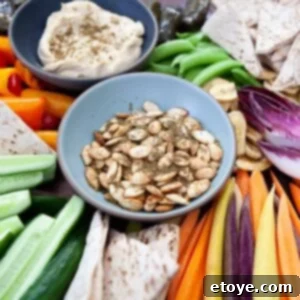
Roasted Spiced Pumpkin Seeds
Take roasted pumpkin seeds to the next level with incredible store-bought Za’atar, Berbere, or Shichimi Togarashi seasonings!
📌Pin Recipe
Ingredients
- 1 cup dry untoasted pumpkin seeds (hulled or unshelled)
- 2 teaspoons olive oil (plus more for baking sheet)
- 1 to 2 teaspoons global spice blend of your choice (Za’atar, Berbere, or Shichimi Togarashi)
- Sea salt to taste
Instructions
- Preheat your oven to 350 degrees F (175 degrees C). Line a baking sheet with parchment paper and lightly slick it with olive oil or spray with cooking spray to prevent sticking.
- In a medium bowl, combine the pumpkin seeds, olive oil, and your chosen spice blend. Toss everything together until the seeds are evenly coated. Don’t be afraid to use a generous amount of spice; the flavors will mellow slightly in the oven.
- Spread the seasoned pumpkin seeds in a single, even layer on the prepared baking sheet. Roast for approximately 20 minutes, or until the seeds are golden brown, fragrant, and wonderfully crunchy.
- Immediately remove the pumpkin seeds and parchment paper from the hot baking sheet to a cooling rack or plate (this prevents them from overcooking and burning). Sprinkle generously with additional sea salt to taste while still warm, then let them cool completely before storing in an airtight container.
